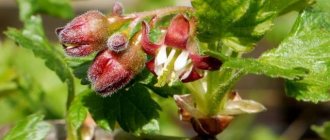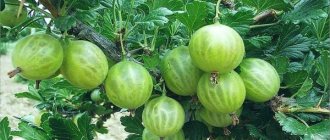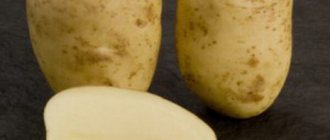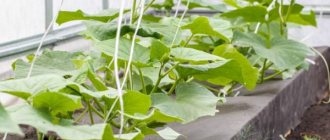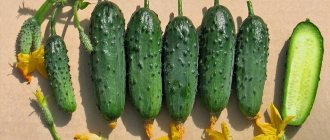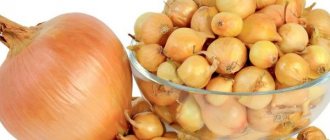Why graft gooseberries
There are several reasons for grafting gooseberries:
- Creation of standard plants. When the crown is slightly raised, it is easier to care for the “berry tree”: harvesting and pruning. With uniform lighting, the berries are relatively larger and have better taste. Flowers and ovaries suffer significantly less from late spring frosts.
- The beautiful appearance of the plant, which is taken into account in landscape design.
- Used in small areas as it saves space.
Pros and cons of growing gooseberries on a trunk
Growing gooseberries on a trunk has its own distinctive characteristics, which are characterized by positive and negative sides.
The main advantages of such cultivation include:
- a standard bush covered with flowers and berries looks extremely impressive and attracts attention;
- the risk of damage to leaf blades and berries by powdery mildew is reduced;
- such a bush produces fruit one and a half times more than usual;
- it is more convenient to care for and treat with special means;
- it is easier to care for the tree trunk area;
- comfortable harvesting.
When choosing this method of cultivation, it is recommended to take into account the negative aspects:
- require more care: remove root shoots and shoots appearing on the trunk;
- despite the large size of the fruits, the yield decreases;
- in areas with cold climates, the risk of frost damage increases if the variety is not frost-resistant enough;
- the likelihood of damage to the plant by currant glass increases;
- the vital activity of the plant depends on the trunk, the main and single shoot.
What are gooseberries grafted onto?
Gooseberry grafting is carried out on berry crops (red currants and gooseberries), less often on fruit trees.
Fruit trees and bushes
You can grow gooseberries on a fruit tree. But it is suitable for experimental gardeners because it involves a lot of risk.
Cherry is used extremely rarely, despite the success of foreign experiments. Survival rate is average. In practical use, numerous rejections of the grafted parts have been observed. But with successful grafting, the appearance of large berries with non-standard taste characteristics is noted.
Rowan and plum are used if it is not possible to choose a suitable rootstock. The percentage of surviving scions is low. The grafted part does not hold well.
Thus, the use of fruit trees is considered as experimental options.
When grafting, golden currant seedlings are used, and gooseberry cuttings are grafted onto its trunk. Currant rootstock must be grown from cuttings or layering yourself. Moreover, forcing is not carried out by a bush, but is aimed at the formation of vertical shoots.
In addition, experienced gardeners recommend using yoshta, which is a hybrid plant of currants and gooseberries. Advantages: straight shoots, quite strong, resistant to winter frosts, immune to harmful insects and common diseases. For this rootstock, it is necessary to leave a single shoot and pinch off the resulting lateral shoots, which will entail the rapid formation of a thick trunk.
See also
Description of Finnish gooseberry varieties, cultivation and propagationRead
Compatible gooseberry varieties
In the process of choosing a rootstock, the question arises: how to graft gooseberries onto gooseberries? For such a procedure, you need to choose the right variety:
- Oregon gooseberry: great for areas with a lot of rainfall or deep water, as currants tend to develop dropsy (edema) in such conditions.
- Common gooseberry: Excellent as a rootstock, standing alongside Oregon and golden currants.
- The Malachite variety is characterized by an average ripening period, the bush is vigorous, resistant to low temperatures, which is its advantage.
Methods for obtaining a standard
To make a standard form of gooseberry, you need knowledge and experience, as well as a great desire, and the technique itself can be carried out in two ways:
- Stage-by-stage formation on a short or taller trunk.
- With the help of vaccination.
Forming step by step
For this method, gooseberries can be grown on their own roots.
Scheme of step-by-step pruning of gooseberries.
- When planting in a permanent place and completely rooting the bush, only one, but the strongest shoot is left, as a rule, the most upright . That is why, for the formation of standard gooseberries, varieties with straight-growing, dense, thick shoots are preferred.
- All shoots except one are cut out at ground level, and the top of the one left is shortened.
- Blinding is carried out on the abandoned shoot . This is a procedure for removing all the buds that are located from the bottom of the shoot, but leaving the top 4–5.
- In the first and second years of growth of this form, all shoots that develop from the remaining buds are shortened by half . You need to focus on the bud that looks up on the shoot.
- In subsequent years, the shoots are no longer shortened, but only partial pruning is carried out on those shoots that have bear fruit and have aged, as well as those that grow inward, or are braided, as well as those that are diseased or broken.
- Those growths that appear on the trunk and near it must be removed in a timely manner, preventing the plant from losing roots and nutrients.
Grafting method
- For grafting, golden currant seedlings are used and cuttings of cultivated gooseberries are grafted onto its trunk.
- Currant rootstock is grown independently from layering or cuttings, but forcing is carried out not by a bush, but by one vertical shoot.
Grafting gooseberries onto yoshta - the photo shows the growth in one season.
According to experienced gardeners, Yoshta (a hybrid of currants and gooseberries) serves as a very good rootstock . Its shoots are smooth, straight, strong, winter-hardy, and not affected by diseases and pests. Such a rootstock is also left with one shoot, and the side shoots that appear on it are not removed, but pinched, this contributes to the rapid thickening of the trunk itself.
Stem height
The height of a gooseberry trunk grafted onto gooseberries (a) and golden currants (b).
The principle for determining the height is as follows: if the rootstock is thin , then the height of the trunk is chosen to be about 120–130 cm. Such a trunk requires good, powerful support.
If the rootstock is strong , powerful, with a thick shoot that can itself hold a powerful “head”, then the grafting is done lower, to a height of 50 to 120 cm.
Vaccination times and methods
Methods for grafting standard gooseberries.
Each method has its own optimal time period.
- If the cutting is prepared in advance, then the grafting is done from the beginning of July, including the first days of September (if the temperature at night is not lower than 15 ᵒC). This can be done in a side cut.
- If the timing falls in late summer and early September, then it is better to do it with an oblique wedge or butt.
- In July-August - budding with an eye.
- The end of February is suitable for improved copulation (indoors only).
Standard gooseberry on currant rootstock, first year of fruiting.
Necessary conditions for the procedure
For the vaccination procedure to be successful, you need to:
- For winter grafting, it is important to properly prepare cuttings and rootstock. Cuttings must be strong annual shoots. Rootstock: 1-2 year old currant seedlings. Before spring grafting, the cuttings should remain dormant.
- For grafting in the spring, prepare cuttings in the first weeks of winter, store them in the snow, and move them to the refrigerator when it gets warm.
When should vaccination be done?
The procedure for grafting gooseberries is carried out in summer, winter or spring. Grafting by cuttings onto previously prepared and sufficiently strengthened rootstock seedlings is carried out during the growing season:
- from July to mid-September - in a side cut;
- in the last weeks of summer - in the butt or with an oblique wedge;
- from July to August - budding with a peephole with a piece of wood.
Excellent results are achieved by vaccination in winter and spring, which is carried out in the last week of February - early March.
conclusions
The berries are ripening on standard gooseberries.
Recently, the demand for standard forms has been increasing , and nurseries are starting to grow seedlings specifically for such purposes. Such “bushes” come out fully formed, with a closed root system, and the price, compared to bush forms, is not much higher.
When planning to grow standard gooseberries, think about what the rootstock and scion will be like, where to get it, how to grow it, and how to preserve it, take into account the fact that you won’t get berries for the first 3-4 years , but in 5-6 years you will get very few . Evaluating all the pros and cons, decide whether you need a standard gooseberry in the garden, or limit yourself to ordinary bushes, but expect a good harvest of tasty berries.
How to plant gooseberries on a trunk: technological process
Taking into account the time of the grafting procedure, cuttings are prepared in the fall or immediately before the grafting itself.
Scion preparation
For winter grafting, cuttings of a varietal plant (scion) are prepared. The thorns are cut off from them. Stored at temperatures from 0 to 3 °C. For storage, wet sand, peat or sawdust is used.
Preparation of the rootstock
Rootstocks for grafting in winter are dug up in the autumn. They must be stored in the basement; wet peat, sand, and sawdust are used. The optimal temperature for storage is 0-3 oC.
Step-by-step grafting technology
In the process of cultivating gooseberries with a trunk, grafting is used in the butt, side cut, T-shaped cut and in the split.
It is necessary to choose so that the rootstock and scion match each other in diameter. The vaccination procedure is carried out in February-March. Rooted rootstock cuttings are placed in a cold basement in the fall. After grafting, until both parts grow together, they are placed in conditions with a temperature range of 18 to 23 degrees. Store in a cool place until planting.
At the end of the summer period, grafting is carried out on the mother plant. To do this, you need to form a bush for propagation with layering directed upward. Grafting is carried out in the butt using a cutting that is almost lignified. In the autumn, such a scion will take root; the bush with the grafted cuttings is divided.
Grafting into clefts is carried out in the spring, even before the onset of the growing season, and at the end of summer.
It is recommended to carry out grafting using the improved copulation method according to the following plan:
- Identify a strong, vertically formed sprout on the rootstock. Cut the remaining shoots to the base.
- Select a scion cutting that matches in diameter.
- Make an oblique cut on the scion from below, try to ensure that its length corresponds to three sizes of the diameter of the cutting. Next, place it in a container with a Heteroauxin solution.
- Make a similar cut on the rootstock at the required height. As a rule, this is 0.6-0.8 m. Moisten the resulting cut with “Heteroauxin”.
- Remove the cutting from Heteroauxin and make a tongue a couple of millimeters in size on the bottom cut.
- Attach the edge of the cutting to the rootstock and mark the area of the cut. It should coincide in location with the tongue, and perform similar on the rootstock.
- Connect both parts according to the puzzle pattern - tongue into tongue.
- Tie the grafting area with a special tape (self-destructive) or other similar material.
- Cover the cut of the cutting from above and cover the grafting site with tape with garden varnish. The buds on the entire surface of the trunk, located from the grafting downwards, are blinded. Tie the plant to a support.
See also
Description and characteristics of the Komandor gooseberry variety, planting and careRead
Storing rootstock for the trunk
In late autumn, the rootstock is dug up and buried in the basement in wet peat, fine sawdust or sand.
- Cuttings are also harvested in late autumn (before sub-zero temperatures) and stored under the same conditions. For ease of use, the spikes can be cut off.
- After vaccination, the entire “set” must be stored for about 2 weeks at a temperature of about 20 ᵒC. To do this, special boxes are prepared in advance and gooseberries are placed there, and then everything is covered with a 1:1 mixture of peat and sand.
- After standing and warming up, the boxes are transferred to the basement and kept until the moment when planting can be carried out.
- A month after planting in open ground, the grafting strap needs to be loosened, and after another 2 weeks, removed.
- When the scions reach a length of 10 cm, they are pinched. If the processes progress successfully, a ready-made standard plant will be formed by the fall of the same year.
How to grow and care for standard gooseberries?
To obtain a standard form of gooseberry, certain knowledge is important. Planting and care require simple but important procedures. As a rule, growing standard gooseberries consists of two methods:
- formation in stages on a long or low trunk;
- using vaccination.
It is believed that it is easier to get gooseberries from your own trunk.
Action steps:
- During the first year, a standard is formed.
- From the spring of the second season, the sprout is cut off directly at the level of formation of the crown part.
- Leave about 4 buds below the cut. They should be located on different sides, the distance between them should be from 5 to 8 cm, remove the remaining ones.
You can get a standard of the desired height from all vigorous varieties: Kamenyar, Ruby pendant, Neslukhovsky and others. Choosing the right variety is an important condition. Large-fruited varieties are predominantly selected.
How to form a standard gooseberry
The formation of the standard form begins from the moment the seedling is planted in the ground. For this purpose, you should choose a well-lit area of the garden. In the first year, caring for the future standard gooseberry is not so difficult: it does not need pruning and requires watering, weeding and fertilizing.
In the second year, the seedling continues to grow and develop; its care remains the same, but with one nuance. As a rule, at this time several replacement shoots are formed - it is necessary to choose the strongest one and located perpendicular to the surface of the earth. The rest need to be removed.
After harvesting, the main plant should be removed from the soil and the selected shoot should be left, which will subsequently form a trunk. The young plant must be regularly watered, fed, and when it reaches a height of 150 cm, tied to a support in advance of winter.
The very next season, standard gooseberries will bring a bountiful harvest of large berries. During the third season, the gooseberries continue to grow; no special procedures are required until harvesting. Then it is necessary to prune all the branches, shortening them to the first bud, and the green shoots must be removed. By autumn, the cut branches will grow and develop.
At 4 years old, the plant has already formed a powerful root system, so you can remove all shoots at ground level immediately after harvesting. In the spring you can leave a couple of replacement offspring. This procedure should be repeated annually.
In the case of working with an adult shrub, you can form it on the basis of 1-3 stem shoots, refining it annually in the spring. For this purpose, all dense branches are cut off at the base of the bush, leaving 1 to 3 shoots, and all green shoots are removed. At the end of the harvest, all old branches should be cut off, and the soil around the plant should be loosened, fertilized and watered. This is quite simple to do, given the features of the form.
All the procedures described above will allow sunlight to better penetrate the crown, which will cause the berries to ripen faster, become larger and juicier, and the risk of developing fungal infections will be reduced. Harvesting from such a bush is also much easier than from a traditional bush.
If a gooseberry seedling was purchased from a nursery, it will have from 3 to 6 crown branches. The central branch needs to be slightly shortened, and the rest should be cut so that the crown takes on a spherical shape. After 4 years, it will develop fully, it will be possible to remove the old branches, and leave the young shoots of the crown unchanged.
How to properly form and trim a bush
When the grafted shoots grow, it is necessary to remove all leaf blades and thorns on the rootstock. There is no need to allow them to germinate during the summer. It is also important to remove root growth. If necessary, it can be used as additional rootstocks to obtain other varieties. An important condition is the removal of shoots during the life of the plant.
When the grafted parts reach 20 cm in length, remove their growth points. This is done to stimulate branching of shoots in the current season. Further formation is carried out arbitrarily, taking into account personal desires.
The work of pruning bushes is simple, and getting a spectacular spherical shape is not difficult. To get a sphere:
- at the end of the second season you should try to grow about 6 leading shoots;
- shorten the main conductor by 1/8 of the increment length;
- Cut the remaining branches shorter, giving the crown a rounded shape.
When using such pruning, the rejuvenation process is carried out after 6 years. It is necessary to remove old branches, but gradually, maintaining symmetry. All shoots that have grown below the grafting site are promptly removed.
How to make standard gooseberries on your site
Thanks to the advantages of standard forms, they are becoming increasingly popular. The prices for such seedlings are quite high, so gardeners are looking for ways to reconstruct shrubs with their own hands. One method is as follows:
- Choose the most powerful, straight, vertically growing gooseberry shoot.
- All branches except the selected one are deleted.
- The side shoots of the abandoned shoot are cut off to the height of the trunk.
- Place a polyethylene tube on the future trunk that does not allow light to pass through.
- The lower end of the pipe (10 cm) is buried in the ground.
- Install a peg for support.
- The root shoots are removed annually.
- Over the next years, the crown is formed, leaving no more than 5 branches.
You can get a tree not using your own rooted seedling, but by grafting onto golden currants. Some gardeners who are good at this method graft several varieties, creating an elegant, interesting tree with different types of berries.
Tips for gardeners on carrying out the procedure
When carrying out work, it is important to consider the following nuances:
- Install the support simultaneously with planting. For support, a wooden stake is used, which is important to clear of bark and soak the lower end.
- The garter must be done three times: two on the trunk and on the crown. If the bush is productive, then to prevent branches from breaking off, the support is taken longer, and fixing bases are drawn from it in several directions.
- When planting several bushes, fastening is done on horizontal trellises.
Standard gooseberries are a decoration and are successfully used in landscape design. It is easier to care for, but such a plant requires special care and timely, correct pruning.
Rules of care
Although gooseberries are considered a drought-resistant crop, regular abundant watering, especially during flowering, will ensure a good harvest of berries. The roots of standard gooseberries are located at great depths, so water should saturate the soil at least 40 cm deep. The rate of one-time watering under a tree is about 50 liters. The plant needs loosening of the soil and further mulching, after which a crust does not form on the surface, weeds do not multiply, and moisture is retained in the soil. Sawdust can be used as mulch. straw, mown grass, peat.
In the year of planting, fertilizers are applied to the planting hole. The next feeding is carried out in the second year of growth during the appearance of buds, then during flowering and the last one during the period of setting berries. A mixture of nitrogen, potassium and phosphorus is used for this.
The standard gooseberry needs constant support in the form of a peg installed on the wind side. It is cleared of bark, treated with a special impregnation to prevent rotting, and painted. Important! The plant is tied in two places in a figure eight pattern - in the middle of the trunk and at the level of the crown, so that constrictions do not form.
Periodic pruning is necessary to obtain a beautiful and functional crown of standard gooseberries. During the first, they try to give it a rounded shape. After five years, pruning is carried out to rejuvenate the plant, removing old and diseased branches.
It is very difficult to cover standard gooseberries for the winter. Experts advise carrying out the simplest measures before the winter cold - increasing the layer of mulch on the tree trunk, hilling and covering the trunk with spruce branches.
